President Bush visits Clinical Center
 |
Dr. Marston Linehan (left) and President Bush
|
President George W. Bush talked with Dr. Marston Linehan (left), chief of the urologic oncology branch in NCI’s Center for Cancer Research, during a visit to the NIH Clinical Center on Jan. 17. While here he met with patients and staff on 3SW and participated in a roundtable discussion on advances in cancer prevention. The meeting was, Bush said, "to let the American people understand what kind of work takes place here and some of the practical applications of the discoveries that are being made." It was Bush’s fifth trip to NIH.
HHS Secretary Mike Leavitt led the roundtable discussion. Participants included Dr. Elias Zerhouni, NIH director; Dr. John Niederhuber, NCI director; Dr. Francis Collins, NHGRI director; and patient advocates Grace Butler and Becky Fisher. In opening the session, Bush said, "I love coming to the NIH, it is an amazing place. It is an amazing place because it is full of decent, caring, smart people, all aiming to save lives. And I truly believe the NIH is one of America’s greatest assets. And it needs to be nourished."
Back to Top
New chief to lead rehabilitation medicine department
by Jenny Haliski
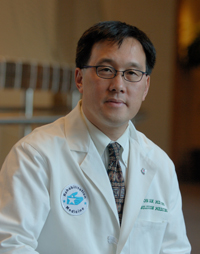 |
Dr. Leighton Chan
|
The CC Rehabilitation Medicine Department welcomed Dr. Leighton Chan as its new chief in January.
Before accepting the CC position, Chan was co-director of the pulmonary rehabilitation program and assistant medical director for the rehabilitation clinic at the University of Washington Medical Center in Seattle. In addition, Chan served as associate professor in the Department of Rehabilitation Medicine at the University of Washington.
As chief, Chan said his goals for the department will be to continue to provide quality consultation services for intramural investigators throughout NIH, to increase the awareness of the effects of disability and health care disparities throughout the United States, and to encourage the use of functional assessments, which he considers crucial outcome measures in health care. Chan said that most people think of health care disparities in both research and providing care in terms of racial and ethnic groups, and do not realize that health disparities may also be related to cognitive, mobility, and communication disabilities—issues regularly encountered in rehabilitation medicine.
"What’s clear to us now is that disability, above and beyond other demographic factors, can predispose individuals to poorer health outcomes," Chan said. "There are unique things about being disabled that lead to problems. For instance, individuals who have difficulties with mobility have a lower likelihood of receiving preventive health care, such as mammograms and Pap smears, because it’s difficult for them to complete the movements required by the tests. We will continue to emphasize to these patients, their providers, and intramural researchers the importance of preventive health care for those with physical disabilities."
Chan said the reputation of NIH and the sense of family at the CC drew him to the position. Chan and his wife, Beth, are both originally from the East Coast, so they are looking forward to being closer to family members in Boston and Manhattan.
"Dr. Chan is recognized as an outstanding teacher and clinical researcher and we are delighted to have him join the Clinical Center team," said Dr. John I. Gallin, CC director, in announcing the appointment. "He was chosen from a highly competitive field of candidates after an extensive national search."
Chan received his BA degree from Dartmouth College, with a major in political science. He graduated from the UCLA School of Medicine in 1990. Chan then completed postgraduate training in physical medicine and rehabilitation at the University of Washington, where he earned the MS and MPH degrees. He completed a Robert Wood Johnson Clinical Scholar Fellowship and was a Congressional Fellow for the Honorable Jim McDermott (Washington).
Chan’s research interests include health services, the quality of care given to Medicare beneficiaries, and Medicare payment policy issues. He has published more than 40 peer reviewed articles and numerous book chapters.
Chan’s honors include the Young Academician Award from the Association of Academic Physiatrists, two outstanding teacher awards from the UW School of Medicine, and a Presidential Citation Award for excellence in research by the American Academy of Physical Medicine and Rehabilitation.
Back to Top
"No child will be without a doll"
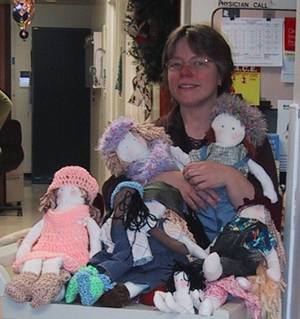 |
Sarah Yu, at the Clinical Center since 2001, stands behind her stack of dolls
Job: biologist in Nuclear Medicine
|
About 30 children in the Nuclear Medicine Department (NMD) day hospital and pediatric clinic will have a cuddly doll from Sarah Yu, a research biologist in NMD, to hold on to this winter while they receive treatment at the Clinical Center.
A screaming child sparked the idea. Yu, who is not routinely involved in patient care, overheard the cries of a four year-old girl who was about to be scanned last spring. "When you hear a small child screaming, it reverberates," she said. Yu, who creates dolls in her spare time, happened to have a toy in her pocket and gave it to the tech to give to the girl. The child was so fascinated with the toy that she was calm enough for NMD staff to complete the scan. Afterwards she talked with the NMD receptionist, who said although they try to keep a small stash of toys at the desk for the kids, it was difficult to keep it stocked up because it relied on donations. "That’s when I decided I’d start bringing things also," Yu said. She vowed that every child at the CC who wanted a doll could receive one from her. Yu made approximately 30 dolls in time for Christmas.
Yu, who has no children herself, said she spends about 20 hours on each doll, often during her long commute on the J9 bus from Gaithersburg. Children in her Sunday school class help with stuffing the dolls.
Back to Top
CC News welcomes new editor
 |
|
New CC News Editor Jenny Haliski
|
The CC News welcomed a new editor and writer, Jenny Haliski, in late December.
Before coming to the CC, Haliski worked for six years at the Advisory Board Company, a health care consulting company in Washington, D.C. For five years of her tenure at ABC, Haliski served as the founding multimedia editor for the Health Line Group, an online news division publishing seven daily health policy publications, including American Health Line, California Healthline, iHealthBeat, and reports on HIV/AIDS, women’s health, and access to care for the Kaiser Family Foundation.
A native Oregonian, Haliski earned her BA in journalism and German from the University of Oregon. She said she feels the fact that she will be working in a building named in honor of Senator Mark O. Hatfield, from her home state, is a sign that she’s in the right place. "I was looking for a career change that would allow me to write and edit stories related to clinical health care issues instead of health policy, so the NIH Clinical Center is a great fit." In addition, Haliski said her private practice as a certified massage therapist sparked her interest in writing and working in a hospital setting, and NIH’s active bike commuting club drew her to the agency.
After earning her undergraduate degree, Haliski spent a year studying international journalism and completing internships at German magazines and newspapers as a Fulbright scholar in Hamburg, Germany. She then completed her MA in German and European Studies from Georgetown University’s School of Foreign Service and decided to live permanently in the Washington, D.C., area. "I love the diversity and cultural opportunities in this region," Haliski said.
Haliski said she is excited about the opportunity to work on the NIH campus so she can report on ongoing activities at the CC. "Everyone I’ve spoken with loves coming to work here and turning the NIH CC’s mission into a reality. I’m honored to be a part of that by helping CC staff know what’s happening throughout Building 10 and beyond and shining a spotlight on the incredible work that occurs here every day. I hope staff will use me as a resource to share their stories, as CC News is really a publication that belongs to, and should reflect, the staff and patients," Haliski said.
Haliski welcomes CC News submissions and story ideas from all staff. She may be reached at 301-594-5789 or haliskij@mail.nih.gov.
Back to Top
In memoriam: "Mike" Harrison
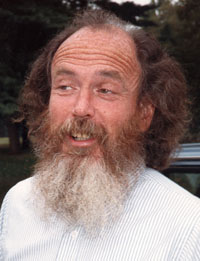 |
"Mike" Harrison
|
John Roland "Mike" Harrison, an expert on the Clinical Center building and its subsequent additions, died Oct. 3 of a heart attack at age 71.
Born in St. Louis and raised in College Park, Harrison grew up on the Building 10 construction site; his father was supervisory engineer of hospital construction for the Army Corps of Engineers. "Mike came and played in the dirt while the building was going up," said Jim Wilson, current chief of facilities for the CC and a long-time friend of Harrison’s.
Harrison earned a degree in mechanical engineering from the University of Maryland and came to NIH in the spring of 1957 as an officer in the Public Health Service. Assigned to open the new Ambulatory Care Research Facility in 1981, Harrison was appointed building services manager for all of Building 10. Harrison retired from the PHS in 1987 at the rank of captain and remained on campus for another dozen years, mostly as a contractor for and primarily as an authority on issues involving the CC.
Larry Eldridge and new executive director of the Edmond J. Safra Family Lodge at NIH, said that Harrison "was an incredibly knowledgeable person" who was a "strategic thinker" and "very dedicated to the quality of the facilities."
Outside of work, Harrison was passionate about racing and engines. "He raced high-performance boats on the Potomac River and built engines for them," Wilson recalled. "He was also a world-renowned expert on Corvairs."
"He knew where every room and every elevator was in the entire building, by number," said NCI’s Pat Schettino, Harrison’s companion for the past 20 years. "He knew it backwards and forwards."
Colleagues recalled him as competitive and constantly engaged, whether it was doing the newspaper’s crossword puzzle every morning or playing cribbage on a set he kept in his desk. "He didn’t like to lose. And he was a fine writer. He had the English language by the [tail]," said colleague Don Sebastian of the CC Office of Facility Management.
"Mike was a very giving man who touched a lot of lives in a very positive way," Schettino said. "He was a man of strong principles and was willing to stand up for them. He approached everything with the intent of doing the very best he could and he took the time to make that happen. He was very passionate about NIH and about maintaining the facility so the work could go on."
Harrison is survived by a son, J. Michael Harrison, and a sister, Rhoda Walker. The family suggests memorial contributions may be made to the American Heart Association or American Cancer Society.
Back to Top
Recently retired Safra Lodge head practiced ‘art of the possible’
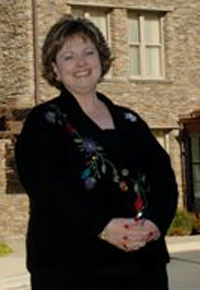 |
Jan Weymouth in front of the Safra Family Lodge
|
After 35 years employment with NIH, Jan Weymouth retired on Jan. 3 as executive director of the Safra Family Lodge. Larry Eldridge will serve as the lodge’s new executive director. "It’s been amazing," Weymouth said. "It’s almost like a family. Everyone feels compelled to push forth the mission of improving the health of the nation. It’s been a privilege to work in some small capacity to do that."
Weymouth began working at NIH in 1970 after graduating from college. Working for NICHD and NCI, Weymouth coordinated conferences for the Fogarty Center. Of the many notable people Weymouth met in that capacity, one of the most fascinating was anthropologist Margaret Mead who in 1976 chaired a Fogarty International Center global warming conference in North Carolina that Weymouth coordinated. "She seemed bigger than life and she was carrying her signature staff and a big satchel when I met her," Weymouth said. "I asked ‘Dr. Mead, what’s in that satchel?’ and she said, ‘All my makeup.’ She was an extraordinary woman!"
Weymouth left the Fogarty Center in 1977 to work for the NIH Division of Space Management at a time of unprecedented growth at NIH. After the Ambulatory Care Research Facility was built, the CC created a new position just to manage its growing space and facilities. Weymouth facilitated the first move to the ACRF in 1981.
From 1983 until 2000 she helped manage CC space and facilities, together with Jim Wilson and the late Mike Harrison. (See related story above) So much new construction happened over 35 years that moving people and things became an important skill. The work was interesting, but it required the mindset of a politician, with so many institutes seeing patients and vying for space in the CC.
In 1999 she helped launch the CC’s hospitality services program, at the suggestion of the Patient Advisory Group. The program retrained and redeployed existing staff to the front entrance and to three strategically located hospitality desks to welcome patients and provide assistance.
After Sept. 11, 2001, security tightened, and patients experienced so much trouble getting on campus that they were turning around and going home. In 2001, Weymouth helped develop and establish the extended-visitor pass program, which allows patients and other visitors to be screened, identified, photographed, and given a pass that permits ease of access similar to that enjoyed by CC employees.
In 1999, approval was given to begin program and design work on what would become the Safra Family Lodge. For four years, Weymouth continued work with various teams for the Hatfield Center while planning the interior design and management of the Safra Lodge. Since 2004 Weymouth worked full-time on the Family Lodge and oversaw everything from construction to staffing.
"Jan is the kind of person who knows how to get things done," says Maureen Gormley, CC’s chief operating officer. "Jan knows the ‘art of the possible.’ If I needed to know where to go for information or a solution, I always would go to her," Gormley said. "She is 1-800-CALL-JAN. Jan has a vision and she makes it happen by a combination of creativity and dedication. When the Family Lodge was only a paper rendering, she told me that she could already walk through its halls in her mind. Not only did she make sure the Family Lodge would be comfortable and supportive of guests’ needs, she gave the place a heart. She recruited a staff of people who embody her own philosophy. Their primary interest is making the guests comfortable and often they stay beyond their tours of duty to be with the families."
Over the years Weymouth said she "morphed into whatever they needed for me to do. But the Family Lodge, which opened in 2005, was the most special. I love this building; I love what it does. Every day I am rewarded when guests say to me, ‘I can’t believe how NIH takes care of us, in so many ways.’ We’ve created this unbelievable environment. I know I am leaving something behind that will be here for a very long time, and will always do this kind of good work."
On her own, Weymouth probably would have continued working for several more years; she’s worked since she was 15 years old and finds it energizing. Her husband, Rob, who is also retiring from NIH, filled out her retirement document, knowing his wife would never do it. Under reason for retiring, he wrote, "to have fun in the sun." Weymouth said, "I don’t think of this as retirement, but as a renaissance."
Back to Top
Patient recruitment a highlight of Cirelli’s varied career
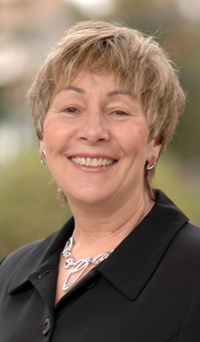 |
Dottie Cirelli
|
Dottie Cirelli, who retired in January as chief of the patient recruitment and public liaison office, is a case study in how to build a career at NIH.
Cirelli served for nine years as a substance abuse counselor for the Arlington County Department of Human Resources.
"One of my dreams was to work at the NIH, which was the premier place to be for research and medicine," Cirelli said. In 1980, she was hired as a research psychologist with NIAAA.
She provided counseling and education services for the Tri-Service Alcoholism Recovery Department at the National Naval Medical Center and collected blood specimens for research conducted by NIAAA.
Three years later, Cirelli helped NIAAA establish its clinical program. Assigned to 3BN on the main campus, Cirelli worked for Ralph Ryback and Markuu Linnoila. Next she moved to CC as a hospital administrative officer, responsible for patient care unit budgets and administrative and facility issues. She also coordinated work on renovations in patient care units for four institutes. Cirelli also ordered monitoring equipment and other supplies, ensuring that everything received safety checks and that all units received whatever they needed, from keys and laundry to needles and bandages. "It was never boring," Cirelli said. "Something always needed attention. I liked interacting with the patients, the nurses, and other patient care staff. I felt I was part of the heartbeat of the organization."
If the unit level gave her the 5,000-foot view, her next position, as assistant hospital administrator gave her the 35,000-foot view: operations and financing. Cirelli was on the team that focused on total quality improvement—giving employees more of a role in redesigning work processes so they were more efficient and cost-effective and improving customer service.
In 1997, a subgroup of the Medical Executive Committee decided that more active patient recruitment was needed to fill intramural clinical trials. Cirelli soon took on her most challenging career post actively managing a centralized patient recruitment service.
Four institutes worked with her at first: NHLBI, NICHD, NIAMS, and NIDCR. She convened work groups to look at processes and data needed and to identify the patient support services needed (e.g., parking, child care, travel) to support recruitment and retention. With a team of three, including staffers Dan Kervich, Dinora Dominguez, and Elaine Robinowitz Smoot, Cirelli was given phones and computers and asked to develop a proposal to increase recruitment for CC, with a special mandate to recruit more minority patients. "We literally worked night and day, not only conducting recruitment but initially answering all of the calls, developing our own database, and creating forms to collect data," Cirelli said.
By opening a call center, attending health fairs and national conferences, sending mailings to doctors, advertising, and capturing media attention, the department increased patient enrollments from 125 out of about 9,000 calls in fiscal 1997 to 3,041 patient enrollments out of 46,796 calls and 12,492 referrals to protocols in fiscal 2006. "We can do a preliminary screening when someone contacts the call center but the institutes complete the evaluation once we refer the patient. Patients may not be enrolled for several reasons. Sometimes they decide after they hear more about the study that they’re not interested. Most of the time, though, they don’t qualify," Cirelli said.
"If you have a question about anything medical, this is the place to ask it. I maintain that no matter where you go, you are not going to get the level of care that you get here," Cirelli, referring to her experience with a family member receiving care at the CC, said. "Most nurses here have a bachelor’s if not a master’s degree, and they know both research and clinical care. And there’s nothing comparable to the physicians. The mission of this organization is wonderful and the people who work here really care. I haven’t met anybody who’s been a patient here who doesn’t say the same thing. They may complain about the bureaucracy, but for the care related to the studies, it’s the best, bar none. That was why I wanted to work here. I wanted to work with the best—and it’s how I feel as retire. I believe in this place, totally, and I am proud to have been a part of it," Cirelli said.
"We will really miss Dottie," Maureen Gormley, CC’s chief operating officer, said. "Her spirit of cooperation coupled with her willingness and ability to work so effectively with people made her a valuable member of the NIH family.
Back to Top
Video spotlights new unit
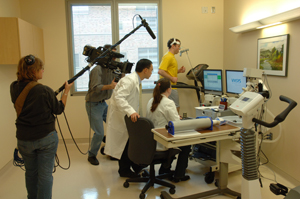 |
Shooting a scene for the informational video describing the new NIH Metabolic Clinical Research Unit
|
Doors to the new NIH Metabolic Clinical Research Unit were open to staff following a ribbon-cutting ceremony on Jan. 25. Attendees had a chance to view the informational video describing the unit and its programs produced by NIDDK. In the video, Dr. Kong Chen (standing center), a biomedical engineer and clinical investigator, describes some of the unit’s special features. This scene deals with exercise testing equipment. See the March issue of CC News for more on the new unit, an important component of the NIH Strategic Plan for Obesity Research.
Back to Top
CC smoke-free campaign
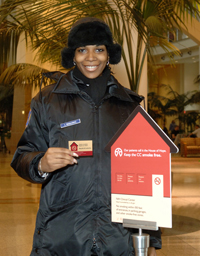 |
India Roulhac
|
New security guard India Roulhac plays an important role in the Clinical Center’s smoke-free campaign initiated in January. She monitors the CC’s outside areas to help get the word out about the effort and the rules—and to share information about how to quit smoking with those who want it. Smoking is not permitted inside any NIH building. At the Clinical Center, it’s also prohibited within 100 feet of any entrance and anywhere between the north entrance of the Hatfield Center and Center Drive, including the stairways to the Children’s Inn.
Back to Top
Pitch in and separate trash from MPW
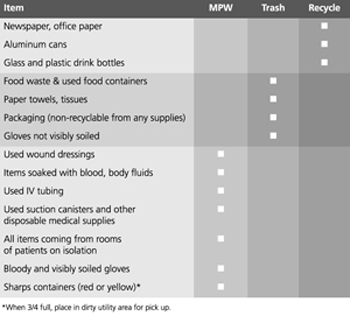 |
Print and clip this chart of guidelines for items that may be recycled or discarded as MPW or trash for reference in your work space.
|
About to drop your lunch container into an MPW receptacle? Don’t do it. Regular trash doesn’t belong there. Only use the red MPW receptacles for the medical pathological waste and help save the Clinical Center about $250,000 each year.
Examples of MPW include clinical specimens, used patient care supplies such as suction canisters, IV tubing, and all yellow and red sharps containers. Unlike regular trash, which is sent to a municipal landfill, MPW must be specially packaged and disposed, usually through incineration. The cost of incinerating MPW, as well as transporting MPW to incinerators, is going up as incinerators are becoming scarcer and are located further away due to incineration facilities closing. Refer to NIH’s online waste disposal guide, http://orf.od.nih.gov/Environmental+Protection/Waste+Disposal/.
The Clinical Center Housekeeping and Fabric Care Department will be supplying 300 new red MPW receptacles to replace the old MPW boxes in patient care areas and Clinical Center labs that support patient care. This will greatly reduce the number of MPW boxes that are used. So that CC staff will have plenty of places to stash regular refuse, the department has increased the number and size of regular trash cans, according to Henry Primas, former department chief and recently appointed staff assistant in the Office of Procurement and Contracts. Primas said encouraging staff to keep regular trash–especially take-out food cartons–out of the MPW receptacles is a major goal of the initiative. "It will save a lot of (MPW) boxes," Primas said. Using fewer boxes saves money. For more on what goes where, talk to members of the Environment of Care teams, said Dr. Michele Evans, hospital safety officer. Teams will be visiting units soon.
Want to help even more? Recycle whenever possible. Containers for recycling paper, cans, and plastic are located throughout NIH campus and Building 10, particularly in the high-use areas and the knuckles between wings.
Above is a chart of guidelines for items that may be recycled or discarded as MPW or trash. Staff are encouraged to post this information above waste disposal areas in their work space for reference. A printer-friendly PDF of the MPW chart is available online. is available online.
Back to Top
News Briefs
MEC leaders named
The Medical Executive Committee in December elected Dr. William Gahl, clinical director of NHGRI, as its new chair and Dr. Henry McFarland, NINDS clinical director and 2006 MEC chair, as vice-chair.
At NHGRI, Gahl also heads the Human Biochemical Genetics Section and serves as senior investigator for the Medical Genetics Branch.
Discovery Channel show featuring the CC airs this month
The Discovery Channel’s television program about the 2006 Discovery Channel Young Scientist Challenge, which involved forty middle school students competing in two days of complex, team-based, hands-on challenges at the NIH Clinical Center in late October, will air three times in February. The air dates are:
Discovery Channel: Feb. 17 at 2 pm
Discovery Kids: Feb. 25 at 9 pm
Science Channel: Feb. 28 at 8 pm
Read more about the program at http://school.discovery.com/sciencefaircentral/dysc/.
NIH-Duke Clinical Research Training Program accepting applications
Applications are being accepted for the 2007-2008 NIH-Duke Training Program in Clinical Research.
Applications are available in the NIH Clinical Center, Office of Clinical Research Training and Medical Education, Building 10, Room B1L403. Additional information regarding coursework and tuition costs is available via the program Web site at http://tpcr.mc.duke.edu.
Enrollment in this program is limited. Interested individuals should inquire with their NIH Institute or Center regarding funding for participation in this program. E-mail queries regarding the program may be addressed to tpcr@mc.duke.edu. The deadline for applying is March 1, 2007. Successful applicants will be notified by July 2, 2007.
NIDA assembles research, clinical communities on opioids
NIDA, together with the NIH Pain Consortium and the American Medical Association, on March 5 will sponsor a two-day conference titled, "Pain, Opioids, and Addiction: An Urgent Problem for Doctors and Patients," at the Natcher Conference Center. The agenda and registration information are available at http://conferences.masimax.com/opioid/index.cfm.
Back to Top
Research volunteers needed for studies
Alcohol metabolism NIAAA is seeking men and women between the ages of 55 and 65 to participate in a study of alcohol metabolism and responses. Participation includes one three-hour screening visit and two eight-hour study visits. Participants must be social drinkers in good health. Compensation will be provided. Contact Shilpa Kumar at 301-451-0308 or ETOHStudy-L@mail.nih.gov.
To participate in any of the following studies, call 1-866-444-2214 or TTY: 1-866-411-1010.
Anthrax vaccine: NICHD seeks healthy volunteers between the ages of 18-30 to participate in an investigational anthrax vaccine study (04-CH-0283). Medical tests will determine eligibility. Compensation provided.
Child allergy clinic: The NIH Pediatric Clinic seeks participants between the ages of 6 months to 18 years for an allergy and asthma study (05-I-0084).
Kidney transplant: An NIH kidney transplant study (99-DK-0120) designed to reduce the need for anti-rejection drugs seeks adults with kidney failure.
Pulmonary sarcoidosis: An NIH study (06-H-0072) seeks adults with pulmonary sarcoidosis.
Rheumatoid arthritis: An NIH study (03-AR-0133) seeks adults 18 or older with rheumatoid arthritis. All study-related tests are provided at no cost. Compensation provided.
Sleep and obesity study: A sleep and weight study (06-DK-0036) seeks obese adults ages 22 to 50 who sleep less than six hours at night. Compensation provided.
Back to Top
New clinical research protocols
The following new clinical research protocols were approved in December:
A Phase I Trial of Monoclonal Antibody HGS-ETR2 (Lexatumumab) in Patients with Refractory Pediatric Solid Tumors, 07-C-0040, Crystal L. Mackall, MD, NCI
An Evaluation of the Tissue Distribution and the Selective Tumor Trafficking of TNF-Bound Colloidal Gold (CYT-6091) Following Intravenous Administration in Subjects with Primary and Metastatic Cancer Undergoing Surgical Resection, 07-C-0043, Steven K. Libutti, MD, NCI
A Phase I Trial of Nelfinavir (Viracept) in Adults with Solid Tumors, 07-C-0047, Philip Dennis, MD, NCI
A Phase 2 Study of O6-Benzylguanine (O6-BG) and Temozolomide in Patients with Glioblastoma Progressing at Least 3 Months After Completion of Primary Treatment with Radiation Therapy and Temozolomide, 07-C-0052, Howard A. Fine, MD, NCI
A Phase I Trial of Enzastaurin (LY317615) in Combination with Carboplatin in Adults with Recurrent Gliomas, 07-C-0053, Howard A. Fine, MD, NCI
A Phase I Trial and Pharmacokinetic Study of Trabectedin (YONDELIS, ET-743) in Children and Adolescents with Relapsed or Refractory Solid Tumors, 07-C-0054, Elizabeth Fox, MD, NCI
A Phase II Study of Sorafenib and Bevacizumab in Epithelial Ovarian, Fallopian, and Peritoneal Cancer, 07-C-0058, Elise C. Kohn, MD, NCI
Prospective, Open-Label, Multicenter, International Study of Mifepristone for Symptomatic Treatment of Cushing’s Syndrome Caused by Ectopic Adrenal Corticotrophin Hormone (ACTH) Secretion, 07-CH-0008, Lynnette K. Nieman, MD, NICHD
Multicenter International Lymphangioleiomyomatosis Efficacy of Sirolimus Trial (The MILES Trial), 07-H-0037, Joel Moss, MD, NHLBI
Effects of Interleukin-1 Inhibition on C-Reactive Protein Levels, Endothelial Progenitor Cell Mobilization and Endothelial Function in Patients with Coronary Artery Disease, 07-H-0055, Richard O. Cannon III, MD, NHLBI
Validation of Cardiac MR Perfusion with Cardiac Catheterization Physiological Assessment, 07-H-0056, Robert J. Lederman, MD, NHLBI
ClinSeq: A Large-Scale Medical Sequencing Clinical Research Pilot Study, 07-HG-0002, Leslie G. Biesecker, MD, NHGRI
A Phase I Study of the Safety and Immunogenicity of a Recombinant DNA Plasmid Vaccine (VRC-AVIDNA036-00-VP), Encoding for the Influenza Virus H5 Hemagglutinin Protein in Healthy Adults, 07-I-0042, Julie E. Martin, DO, NIAID
PET Imaging of Brain Amyloid Using [11C]MeS-IMPY, 07-M-0036, Robert B. Innis, MD, NIMH
Effects of tDCS Over the Cerebellum on Motor Function, 07-N-0049, Leonardo G. Cohen, MD, NINDS
MRI of Alzheimer’s Disease Imaging Amyloid Plaques in Persons With and Without Memory Problems, 07-N-0050, Jeffrey H. Duyn, PhD, NINDS
Back to Top
Upcoming Events
Clinical Center Grand Rounds and Great Teachers Lectures
Wednesday, February 7
Ethics Rounds
The Ethics of Informing Estranged Family Members of Genetic Risks
Catherine Ross, Esq.,
Professor of Law, George Washington University Law School
Wednesday, February 21
Contemporary Clinical Medicine:
Great Teachers
Great Teachers
Pancreas Transplantation: Past, Present, Future
Hans Sollinger, M.D., Ph.D.
Folkert O. Belzer Professor of Surgery, Chairman, Division of Organ Transplantation, University of Wisconsin School of Medicine
Wednesday, February 21
Cutaneous Leishmaniasis in Mali: Understanding its Epidemiology Towards the Identification of a Sand Fly Salivary Antigen-Based Vaccine Jesus G. Valenzuela, Ph.D.,
Head, Vector Molecular Biology Unit, Laboratory of Malaria and Vector Research, NIAID
Shaden Kamhawi, Ph.D.
Core Staff Scientist, Laboratory of Malaria and Vector Research, NIAID
Wednesday, February 28
Gaucher Disease: Expanding the World of Mendelian Disorders and Therapeutic Strategies Using Quantitative High Throughput Screening
Ellen Sidransky, M.D.
Chief, Section on Molecular Neurogenetics, Medical Genetics Branch, NHGRI
Christopher P. Austin, M.D.
Director, NIH Chemical Genomics Center, Senior Advisor to the Director for Translational Research, NHGRI
Back to Top
Clinical Center News, National
Institutes of Health, Building 10, 10 Center Drive, Room 12C440, Bethesda, MD 20892-1504. Tel: 301-496-6787.
Fax: 301-402-2984. Published monthly for CC employees
by the Office of Communications, Patient Recruitment, and Public Liaison. News, article ideas,
calendar events, letters, and photographs are welcome.
Back to Top
|
|


 The information on this page is archived and provided for reference purposes only.
The information on this page is archived and provided for reference purposes only.